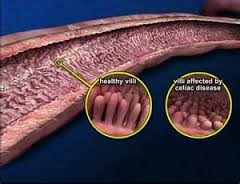Dr Stephanie Seneff on Glysophate and Ciliac Disease
Dr. Mercola Interviews Dr. Seneff (Full Interview)
http://articles.mercola.com/sites/art... Natural health expert and Mercola.com founder Dr. Joseph Mercola interviews Dr. Stephanie Seneff about GMO foods, as well as the increasing incidence of celiac disease and the use of glyphosate. (Full Interview)
Glyphosate, pathways to modern diseases II: Celiac sprue and gluten intolerance
Abstract
Celiac disease, and, more generally, gluten intolerance, is a growing problem worldwide, but especially in North America and Europe, where an estimated 5% of the population now suffers from it. Symptoms include nausea, diarrhea, skin rashes, macrocytic anemia and depression. It is a multifactorial disease associated with numerous nutritional deficiencies as well as reproductive issues and increased risk to thyroid disease, kidney failure and cancer. Here, we propose that glyphosate, the active ingredient in the herbicide, Roundup®, is the most important causal factor in this epidemic.
Xenobiotic
A xenobiotic is a foreign chemical substance found within an organism that is not normally naturally produced by or expected to be present within. It can also cover substances that are present in much higher concentrations than are usual. Specifically, drugs such as antibiotics are xenobiotics in humans because the human body does not produce them itself, nor are they part of a normal food.
Natural compounds can also become xenobiotics if they are taken up by another organism, such as the uptake of natural human hormones by fish found downstream of sewage treatment plant outfalls, or the chemical defenses produced by some organisms as protection against predators.[1]
The term xenobiotics, however, is very often used in the context of pollutants such as dioxins and polychlorinated biphenyls and their effect on the biota, because xenobiotics are understood as substances foreign to an entire biological system, i.e. artificial substances, which did not exist in nature before their synthesis by humans. The term xenobiotic is derived from the Greek words ξένος (xenos) = foreigner, stranger and βίος (bios, vios) = life, plus the Greek suffix for adjectives -τικός, -ή, -ό (tic).
What is Celiac Disease?
Celiac disease is a serious genetic autoimmune disorder where the ingestion of gluten leads to damage in the small intestine. It is estimated to affect 1 in 100 people worldwide. Two and one-half million Americans are undiagnosed and are at risk for long-term health complications.
image: https://celiac.org/wp-content/uploads/2013/04/damanged-villi.png
When people with celiac disease eat gluten (a protein found in wheat, rye and barley), their body mounts an immune response that attacks the small intestine. These attacks lead to damage on the villi, small fingerlike projections that line the small intestine, that promote nutrient absorption. When the villi get damaged, nutrients cannot be absorbed properly into the body. The only treatment currently for celiac disease is a strict, gluten-free diet. Most patients report symptom improvement within a few weeks, although intestinal healing may take several years.
Celiac disease is hereditary, meaning that it runs in families. People with a first-degree relative with celiac disease (parent, child, sibling) have a 1 in 10 risk of developing celiac disease.
Celiac disease is also known as coeliac disease, celiac sprue, non-tropical sprue, and gluten sensitive enteropathy.
Read more at https://celiac.org/celiac-disease/understanding-celiac-disease-2/what-is-celiac-disease/#SScskFccVQH42owc.99
 2
2



